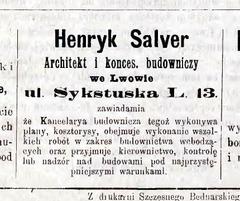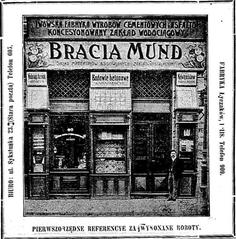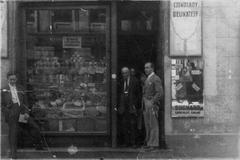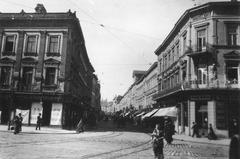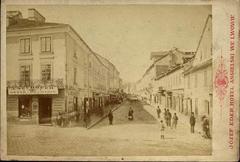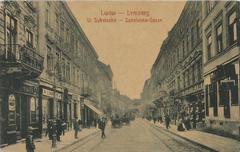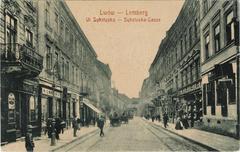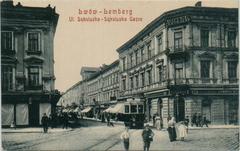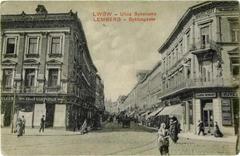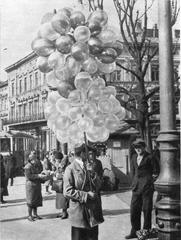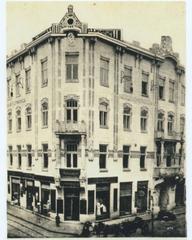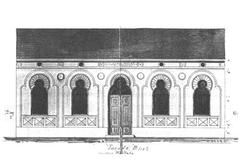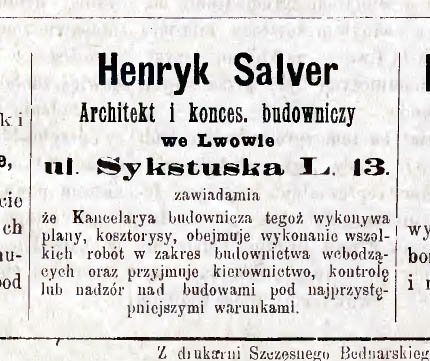
Doroshenka Street Lviv: Visiting Hours, Tickets, and Attractions Guide
Date: 15/06/2025
Introduction: Discovering Doroshenka Street in Lviv
Doroshenka Street, nestled in the vibrant heart of Lviv, Ukraine, stands as a living testament to the city’s layered history, architectural grandeur, and thriving cultural scene. Named for Petro Doroshenko, a 17th-century Ukrainian Hetman, this street not only honors national heritage, but also embodies the diverse influences of Lviv’s Austro-Hungarian and Polish past. Serving as a crucial link between the railway station and the iconic Rynok Square, Doroshenka Street pulses with the city’s social, economic, and artistic energy (Lviv Tourist Info).
With buildings ranging from Neo-Renaissance and Art Nouveau to early Modernism—many recognized under Lviv’s UNESCO World Heritage status—Doroshenka Street narrates the stories of the Ukrainians, Poles, Jews, and Armenians who have shaped Lviv’s multicultural identity (Lviv UNESCO; Modernism Lviv Online). Today, it is a vibrant social and cultural hub, its cafés, bakeries, and boutiques reflecting both tradition and modernity. The street continues to adapt, especially amid recent socio-political changes, and remains a resilient symbol of Lviv’s communal spirit (Young Pioneer Tours).
This guide offers a comprehensive exploration of Doroshenka Street, from its historical and architectural highlights to practical visiting information, cultural activities, and expert travel tips. Whether you are a history enthusiast, architecture aficionado, or just a curious traveler, this resource equips you to navigate and appreciate one of Lviv’s most cherished landmarks (Forgotten Galicia; bbqboy.net).
Table of Contents
- Historical and Urban Context
- Cultural Significance and Identity
- Social Dynamics and Everyday Life
- Artistic and Intellectual Life
- Gastronomy and Café Culture
- Civic Life and Public Events
- Visitor Information: Hours, Tickets, and Accessibility
- Architectural Highlights and Points of Interest
- Visiting Hours, Attractions, and Travel Tips
- FAQ
- Enhancing Your Visit: Visuals and Further Exploration
- Related Articles
- Conclusion and Call to Action
Historical and Urban Context
Doroshenka Street is a vital artery in Lviv, reflecting the city’s enduring commitment to Ukrainian heritage and its ongoing dialogue with European influences. Its development during the Austro-Hungarian and Polish periods endowed it with a rich architectural legacy, making it a central thoroughfare for commerce, public life, and cultural exchange. The street’s strategic position—connecting the railway station to Rynok Square—has long made it a bustling hub for locals and travelers. Tram lines 1 and 9 further reinforce its role as a core axis in Lviv’s public transport network (Lviv Tourist Info).
Cultural Significance and Identity
Honoring Ukrainian Heritage
The street’s name, dedicated to Petro Doroshenko, exemplifies Lviv’s tradition of commemorating national figures and fostering Ukrainian identity. This aligns with a broader city-wide practice of naming public spaces after cultural and historical icons, reinforcing Lviv’s position as a bastion of Ukrainian culture.
Architectural Diversity and Preservation
Doroshenka Street offers a visual timeline of architectural evolution, with buildings in Neo-Renaissance, Art Nouveau, and early Modernist styles. Ornate facades, wrought iron balconies, and decorative motifs bear witness to the city’s multicultural past. Inclusion in the UNESCO World Heritage list has spurred ongoing preservation efforts (Lviv UNESCO).
Social Hub
The street’s cafés, bakeries, and boutiques create a lively urban atmosphere, particularly near Rynok Square and during public events, when open-air markets and performances are common.
Social Dynamics and Everyday Life
Multicultural Community
Doroshenka Street’s history reflects Lviv’s multiculturalism, with influences from Ukrainian, Polish, Jewish, and Armenian communities. This diversity is visible in local languages, religious sites, and culinary offerings. Today, students, artists, and international visitors continue to enrich the area.
Contemporary Changes
Since 2022, Lviv’s population has swelled with internally displaced persons, leading to new services and support initiatives. Doroshenka Street’s adaptability mirrors Lviv’s broader response to change, balancing tradition with evolving needs (Young Pioneer Tours).
Nightlife and Curfew
Though Lviv’s nightlife thrives, the 11 PM curfew (a wartime measure) has shaped social habits, encouraging earlier gatherings and underscoring a sense of solidarity.
Artistic and Intellectual Life
Literary and Artistic Heritage
Historically, Doroshenka Street has been a gathering place for Lviv’s intellectuals and creatives. Today, literary readings, art exhibitions, and cultural festivals regularly enliven its venues, continuing a legacy of intellectual exchange.
Public Art and Monuments
Commemorative plaques and public art installations honor notable residents and events, offering educational insights and fostering a connection to the city’s rich past.
Gastronomy and Café Culture
Culinary Diversity
Doroshenka Street’s gastronomy reflects Lviv’s multicultural history. Ukrainian classics like varenyky and syrnyky share the stage with Polish, Austrian, and Jewish-inspired dishes. Modern cafés serve specialty coffee and fusion menus (Young Pioneer Tours).
Café Rituals
Coffeehouses are integral to Lviv’s social life—a custom dating back to Austro-Hungarian times—making Doroshenka Street a key locale for socializing and relaxation.
Civic Life and Public Events
Civic Engagement
Central to city life, Doroshenka Street frequently hosts civic events, demonstrations, and festivals. On national holidays, the street is adorned with flags and comes alive with music and communal activities.
Local Economy
Shops, restaurants, and services on Doroshenka Street play a vital role in Lviv’s economy, particularly in challenging times. Supporting these businesses helps sustain the city’s social and economic resilience (Young Pioneer Tours).
Visitor Information: Hours, Tickets, and Accessibility
- Visiting Hours: Doroshenka Street is open 24/7. Most businesses operate 9:00 AM–10:00 PM, with variation.
- Tickets: The street is public and free. Entry fees apply only to specific sites (see below).
- Guided Tours: Walking tours are offered by local operators and cultural centers; booking ahead is recommended.
- Photo Highlights: Best spots include intersections near Rynok Square and the railway station, especially during early morning or late afternoon.
- Transport: Accessible by tram lines 1 and 9; pedestrian-friendly with wide sidewalks (Lviv Tourist Info).
- Safety: Lviv is among Ukraine’s safest cities, but observe curfews and local customs.
- Accessibility: Upgrades include ramps, tactile paving, and multilingual signage.
Architectural Highlights and Points of Interest
Urban Layout
Running southwest from Rynok Square, Doroshenka Street is defined by its late 19th and early 20th-century expansion, showcasing influences from across Europe (bbqboy.net).
Architectural Features
- Secessionist and Eclectic Facades: Floral motifs, wrought-iron balconies, and grand entrances.
- Modernist Buildings: Upper Doroshenka’s 1920s–1930s structures, designed by Jewish architects, feature wavy facades and porthole windows (Modernism Lviv Online).
- Protected Residential Buildings: Notably at numbers 14, 16, 17, and 22, recognized as architectural monuments (Science LPNU).
Notable Sites
- Potocki Palace: French Neo-Renaissance style, open daily 10:00 AM–6:00 PM, ticketed entry (bbqboy.net).
- Lviv Organ Hall: Concerts held in a 17th-century Baroque church; tickets 100–300 UAH.
- Ivan Franko National University: Neo-Classical architecture at the street’s western end, tours available by arrangement.
- Pharmacy “Pod Temidą”: Historic pharmacy since 1901, open weekdays 9:00 AM–7:00 PM.
- Grand Hotel: Historic luxury hotel (formerly Hotel Centralny), guided tours by appointment (Forgotten Galicia).
- Wschód Publishing House and Maksym Café: Cultural hotspot in a late 19th-century building, open 8:00 AM–10:00 PM.
Other Attractions
- The Citadel: 19th-century fortress, open daily 9:00 AM–7:00 PM, ticketed entry.
- Ivan Franko Park: Adjacent green space for relaxation.
- Svobody Avenue Intersection: Access to the Opera House and main boulevard.
Visiting Hours, Attractions & Travel Tips
- Entry: Free access to the street; specific sites may charge admission.
- Best Visiting Times: Early morning for tranquility and golden-hour photography; evenings for vibrant nightlife.
- Transport: Best reached by tram or on foot; parking is limited (Life is Travel).
- Accessibility: Mostly flat, but some cobblestones; check individual buildings for wheelchair access.
- Guided Tours: Book online or at tourist information centers (visitukraine.today; MyWanderlust).
- Dining & Shopping: Abundant cafés, bakeries, and boutiques; experience Lviv’s coffee culture (MyWanderlust).
- Photography: Key intersections and historic facades offer excellent photo opportunities.
- Safety: Standard city precautions; police presence is visible.
- Weather: Summers are warm (22–25°C); winters are cold.
FAQ
Q: Are there entrance fees for Doroshenka Street?
A: No, the street is public and free to explore. Some historic buildings may require tickets.
Q: What are the best times to visit?
A: Mornings for quiet sightseeing; evenings for lively atmosphere.
Q: Is Doroshenka Street accessible for wheelchairs?
A: Mostly, but some cobbled areas and historic sites may pose challenges.
Q: Can I book guided tours in advance?
A: Yes, online booking is recommended.
Q: Is parking available?
A: Limited; public transport is advised.
Enhancing Your Visit: Visuals and Further Exploration
For a richer experience, utilize interactive maps and virtual tours on the Lviv Tourist Information portal. Include high-quality images of Doroshenka Street’s architecture, cafés, and festivals, with descriptive alt tags like “Doroshenka Street Lviv architecture” and “Doroshenka Street Lviv visiting hours” to improve accessibility and SEO.
Related Articles
Conclusion and Call to Action
Doroshenka Street is more than a passage—it’s a living chronicle of Lviv’s multifaceted past and present. With its stunning architecture, dynamic social life, and accessibility, it is an essential destination for any visitor. Leverage resources like the Audiala app for audio guides and maps, follow our social media channels for updates, and share your experiences using #DiscoverLviv.
For more details on transportation, visiting hours, and city life, consult the Lviv Tourist Information portal.
References and External Links
- Lviv Tourist Information portal
- UNESCO World Heritage Centre: Lviv – the Ensemble of the Historic Centre
- Young Pioneer Tours: Can You Visit Lviv in 2025 and If So What Should You Do?
- bbqboy.net: The Ultimate Travel Guide to Lviv, Ukraine
- Forgotten Galicia: Ul. Sykstuska & Doroshenka Street Before the War
- Modernism Lviv Online: Last Works of Lviv Jewish Architects
- visitukraine.today: Travel to Ukraine 2025
- MyWanderlust: Lviv Travel Guide
- Science LPNU: History and Architecture of Building 14 Doroshenka
- A Piece of Travel
- Life is Travel
- Lviv Official Tourism Site
